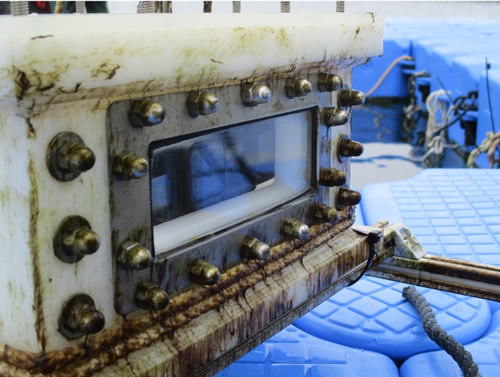WEDNESDAY, MARCH 8, 2023
German research institute Laser Zentrum Hannover has reportedly recently developed an environmentally friendly and efficient laser solution for biofouling. According to the release, laser radiation can be used to lethally damage marine fouling underwater without damaging the underlying coating of the ship's hull.
Laser Removal
LZH scientists reportedly developed a process in which the cells of the fouling are damaged by laser radiation in such a way that the fouling dies and is then washed away by the water after some time.
The researchers conducted the study in the south harbor of Helgoland island, irradiating fouling samples with the laser. After two to four weeks, they returned them to the North Sea for investigation.
“We were able to achieve a clear, time-delayed cleaning effect,” said underwater technology expert Dr.-Ing. Benjamin Emde from the LZH. “With simulated currents, as would be added in real life with a moving ship, the cleaning effect is further enhanced.”
LZH reports that biofouling is a problem because of fuel consumption that leads to emissions, as well as introducing non-native species into foreign ecosystems.

 |
| Photos: LZH |
|
German research institute Laser Zentrum Hannover has reportedly recently developed an environmentally friendly and efficient laser solution for biofouling. |
Emde explained that species displacement is a major risk for biofouling. For example, if a ship introduces foreign organisms into an ecosystem through hull fouling, it can severely disrupt the ecosystem and lead to ships being banned from docking in foreign ports.
Laser cleaning is good alternative in this case, because the introduced biomass is lethally damaged during laser cleaning, rendering it is no longer dangerous for foreign ecosystems afterward.
The project was carried out alongside LZH by the Laserline GmbH, the Fraunhofer Institute for Manufacturing Technology and Advanced Materials IFAM. The project was funded by the Federal Ministry for Economic Affairs and Climate Action.
 |
|
LZH scientists reportedly developed a process in which the cells of the fouling are damaged by laser radiation in such a way that the fouling dies and is then washed away by the water after some time. |
Recent Antifouling Coating Research
At the end of last year, researchers found that environmentally friendly alternatives to copper-based antifouling paint were best at keeping fouling at bay on ships and vessels.
A team of researchers from Chalmers University of Technology, the University of Gothenburg and the Swedish Environmental Institute IVL investigated whether biocide-free silicone paints are a viable alternative to copper-based bottom paints to combat fouling.
The study, which was published in the scientific journal Marine Pollution Bulletin, was carried out over a year at three sites in the Baltic Sea region and the Skagerrak. Black painted surfaces were coated with biocide-free silicone-based paint, while red surfaces were coated with copper-based paint. The white surfaces had no antifouling treatment.
The silicone paint is based on silicone, produced using silicone oxide extracted from sand. The university notes that some silicone paints contain highly fluorinated substances, or PFAS, but the paint tested in the study was fluorine-free.
While the traditional antifouling paint continuously leached copper and other toxic substances, the silicone paint utilized its smooth surface properties to make it difficult for fouling to stick to the hull. The silicone is also self-cleaning, meaning any fouling that does stick is removed as the hull moves through the water.
According to the release, the scientific paper’s collection of ecotoxicological studies shows that silicone paints are significantly less harmful to the environment than copper paints.
Additionally, although the study was carried out over 12 months, the test panels were left at one of the test sites, showing that these results were found to persist over time.
Tagged categories: Antifoulants; Emissions; Environmental Controls; Laser cleaning; Marine; Program/Project Management; Research and development; Ships and vessels; Technology